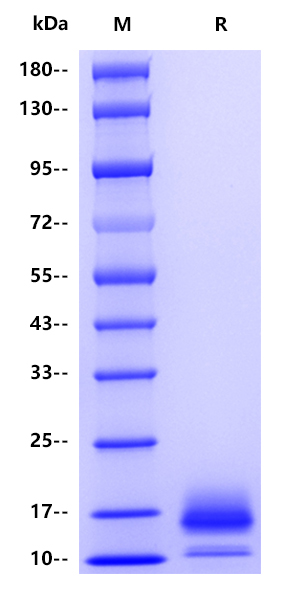产品介绍 评论(0)
物种
Human分子别名
1F5 antigen, 20 kDa homologous restriction factor (HRF-20; HRF20), MAC-inhibitory protein (MAC-IP), MEM43 antigen, Membrane attack complex inhibition factor (MACIF), Membrane inhibitor of reactive lysis (MIRL), ProtectinAccession
P13987表达序列
Protein sequence(P13987, Leu26-Asn102, with C-10*His) LQCYNCPNPTADCKTAVNCSSDFDACLITKAGLQVYNKCWKFEHCNFNDVTTRLRENELTYYCCKKDLCNFNEQLENGGGGSHHHHHHHHHH
表达宿主
HEK293分子量
Theoretical:10.6kDa Actual:11, 15kDa纯度
>95% by SDS-PAGE
内毒素含量
<1EU/μg标签
with C-10*His性状
Lyophilized powder缓冲体系
Lyophilized from a 0.2 μm filtered solution of 0.2M PBS, pH7.4.溶解方法
Reconstitute no more than 1 mg/mL according to the size in deionized water after rapid centrifugation.储存条件
12 months from date of receipt, -20 to -70 °C as supplied. 6 months, -20 to -70 °C under sterile conditions after reconstitution. 1 week, 2 to 8 °C under sterile conditions after reconstitution. Please avoid repeated freeze-thaw cycles.
CD59 glycoprotein, also known as MAC-inhibitory protein (MAC-IP), membrane inhibitor of reactive lysis (MIRL), or protectin, is a protein that in humans is encoded by the CD59 gene. CD59 attaches to host cells via a glycophosphatidylinositol (GPI) anchor. When complement activation leads to deposition of C5b678 on host cells, CD59 can prevent C9 from polymerizing and forming the complement membrane attack complex. It may also signal the cell to perform active measures such as endocytosis of the CD59-C9 complex. Viruses such as HIV, human cytomegalovirus and vaccinia incorporate host cell CD59 into their own viral envelope to prevent lysis by complement.
电泳

2μg(R: reducing conditions)



评论(0)